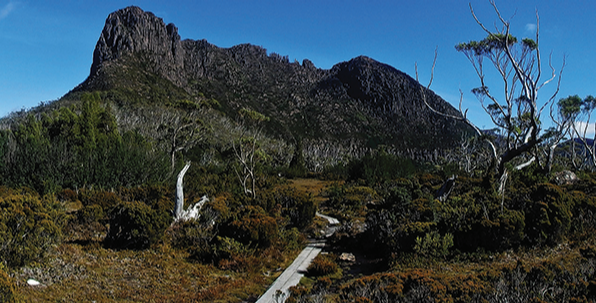
Perhaps it was the splash of the shy platypus as it swam away after a close encounter with us on the trail, or the snarl of Tasmanian devils feeding on carcasses and biting each other at a sanctuary near the start of our trek. Or maybe it was the zzzzzzzzip of a big, black currawong bird unzipping a backpack and helping itself to the snacks in our backpacks, or the THUMP of the Bennett’s wallaby jumping away with a joey in her pouch as we watched from our hut. One thing was certain: we weren’t in Kansas anymore.
Our group of six intrepid Mountaineers of all backgrounds and ages explored the heart of the Tasmanian backcountry by way of the famed Overland Track. If Tasmania (known locally as Tassie) was Oz, the Overland Track would be the yellow brick road. From the moment we stepped foot on this lush island in the far-south of Australia, the flora and fauna were clearly other-worldly: egg laying mammals, Tasmanian devils, joey-toting wallabies, cubic droppings from the aforementioned wombat, trees that drop their bark instead of their leaves, and flowers shaped like Dungeness crab.
We ventured south during an Australian holiday at the end of December, and instead of running into the typical international crowd of hikers doing this well-known trek, we encountered many helpful locals eager to highlight the great treasures of Tassie. Being from the Pacific Northwest, the most exotic animal I’d ever run into was an elk or maybe a mountain goat. On this trip we regularly found ourselves saying, "What is that?" Oh, a duck-billed beaver with webbed feet? Okay. Oh, and that’s a wombat that leaves cubic droppings to mark its territory all over the trail? Okay, well sure, that makes sense. The list went on and on and on.
One of the rangers we met was particularly helpful in explaining the various poisonous snakes to us. How unnerving… but also very helpful! Lots (and I mean LOTS) of things can kill you Down Under.
The only familiar thing on our six-day trek was the sound of rain gear flapping in the wind. An intense storm blew in, and we had to put on our rain coats and ponchos on in a hurry. Just like at home, we still got wet.
Our trek passed through five different ecosystems in six days: eucalyptus forest, high alpine/subalpine, button grass moorland, myrtle beech rainforest, and grassland. The weather did not cooperate initially, so we accelerated our time on the traditional Overland Track to visit a very unique part of the park at the end of the track: the Labyrinth area – essentially the Tasmanian version of the Enchantments. Once the weather improved, we used the opportunity to climb a peak called the Acropolis together as a group. High above the rest of the land, the views added yet another spectacular memory from the trip.
The trek was an unforgettable, super-natural experience for all of us. We were introduced to a unique and remarkable place that certainly left a lasting impression on me, as well as a sense of appreciation for global travel with like-minded adventurers from The Mountaineers. I can’t wait for my next chance to explore in the Pacific Northwest, and beyond!
Interested in experiencing your own global adventure? We have a number of upcoming trips led by our experienced volunteers to help you explore around the world. Find more information and sign up online on our Global Adventures page.
This article originally appeared in our Fall 2018 issue of Mountaineer Magazine. To view the original article in magazine form and read more stories from our publication, click here.
 Eileen Kutscha
Eileen Kutscha